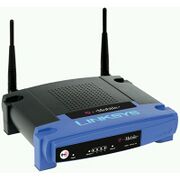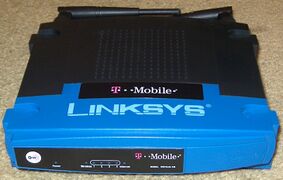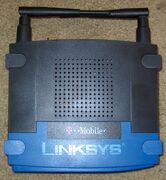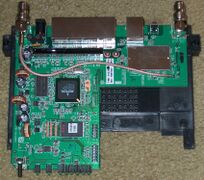You do not need an accout to report a problem with the wiki.
-
Linksys WRT54G-TM
bg (G54) | |||||||||||||||||||||||||||||||||||||||||||||||||||||||||||||||||||||||||||||||||||||
|---|---|---|---|---|---|---|---|---|---|---|---|---|---|---|---|---|---|---|---|---|---|---|---|---|---|---|---|---|---|---|---|---|---|---|---|---|---|---|---|---|---|---|---|---|---|---|---|---|---|---|---|---|---|---|---|---|---|---|---|---|---|---|---|---|---|---|---|---|---|---|---|---|---|---|---|---|---|---|---|---|---|---|---|---|---|
| Wireless-G Broadband Router | |||||||||||||||||||||||||||||||||||||||||||||||||||||||||||||||||||||||||||||||||||||
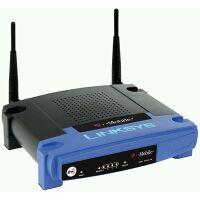 | |||||||||||||||||||||||||||||||||||||||||||||||||||||||||||||||||||||||||||||||||||||
| Support | |||||||||||||||||||||||||||||||||||||||||||||||||||||||||||||||||||||||||||||||||||||
| Wikipedia | |||||||||||||||||||||||||||||||||||||||||||||||||||||||||||||||||||||||||||||||||||||
| InfoDepot Wiki | |||||||||||||||||||||||||||||||||||||||||||||||||||||||||||||||||||||||||||||||||||||
| WikiDevi.wi-cat.ru | |||||||||||||||||||||||||||||||||||||||||||||||||||||||||||||||||||||||||||||||||||||
| 3rd Party Firmware | |||||||||||||||||||||||||||||||||||||||||||||||||||||||||||||||||||||||||||||||||||||
| dd-wrt | |||||||||||||||||||||||||||||||||||||||||||||||||||||||||||||||||||||||||||||||||||||
| OpenWrt | |||||||||||||||||||||||||||||||||||||||||||||||||||||||||||||||||||||||||||||||||||||
| Tomato any flavor | |||||||||||||||||||||||||||||||||||||||||||||||||||||||||||||||||||||||||||||||||||||
| Gargoyle | |||||||||||||||||||||||||||||||||||||||||||||||||||||||||||||||||||||||||||||||||||||
| Platform | |||||||||||||||||||||||||||||||||||||||||||||||||||||||||||||||||||||||||||||||||||||
| Brand • Model • Rev |
Linksys WRT54G-TM v1.1 | ||||||||||||||||||||||||||||||||||||||||||||||||||||||||||||||||||||||||||||||||||||
| Serial number prefix |
CO6, CO61 | ||||||||||||||||||||||||||||||||||||||||||||||||||||||||||||||||||||||||||||||||||||
| FCC ID | |||||||||||||||||||||||||||||||||||||||||||||||||||||||||||||||||||||||||||||||||||||
| IC ID | |||||||||||||||||||||||||||||||||||||||||||||||||||||||||||||||||||||||||||||||||||||
| Board ID |
3763-1410304R | ||||||||||||||||||||||||||||||||||||||||||||||||||||||||||||||||||||||||||||||||||||
| Type |
wireless router | ||||||||||||||||||||||||||||||||||||||||||||||||||||||||||||||||||||||||||||||||||||
| Series |
WRT54G | ||||||||||||||||||||||||||||||||||||||||||||||||||||||||||||||||||||||||||||||||||||
| CPU1 | |||||||||||||||||||||||||||||||||||||||||||||||||||||||||||||||||||||||||||||||||||||
| CPU1 Type |
BMIPS3300 | ||||||||||||||||||||||||||||||||||||||||||||||||||||||||||||||||||||||||||||||||||||
| CPU1 Speed |
200 MHz | ||||||||||||||||||||||||||||||||||||||||||||||||||||||||||||||||||||||||||||||||||||
| Flash1 Chip |
Intel JS28F640J3D75A | ||||||||||||||||||||||||||||||||||||||||||||||||||||||||||||||||||||||||||||||||||||
| Flash1 Size |
8 MiB8,388,608 B <br />65,536 Kib <br />8,192 KiB <br />64 Mib <br />0.00781 GiB <br /> (Parallel) | ||||||||||||||||||||||||||||||||||||||||||||||||||||||||||||||||||||||||||||||||||||
| RAM1 Size |
32 MiB33,554,432 B <br />262,144 Kib <br />32,768 KiB <br />256 Mib <br />0.0313 GiB <br /> | ||||||||||||||||||||||||||||||||||||||||||||||||||||||||||||||||||||||||||||||||||||
| RAM1 Chip |
SK hynix HY5DU561622ETP-D43 | ||||||||||||||||||||||||||||||||||||||||||||||||||||||||||||||||||||||||||||||||||||
| nvram Size |
32K | ||||||||||||||||||||||||||||||||||||||||||||||||||||||||||||||||||||||||||||||||||||
| ETH chip1 | |||||||||||||||||||||||||||||||||||||||||||||||||||||||||||||||||||||||||||||||||||||
| Switch | |||||||||||||||||||||||||||||||||||||||||||||||||||||||||||||||||||||||||||||||||||||
| Ethernet Port Count |
1-100MbE-WAN 4-100MbE-LAN | ||||||||||||||||||||||||||||||||||||||||||||||||||||||||||||||||||||||||||||||||||||
| Wired Standard |
IEEE 802.3/3u | ||||||||||||||||||||||||||||||||||||||||||||||||||||||||||||||||||||||||||||||||||||
| Stock bootloader |
CFE | ||||||||||||||||||||||||||||||||||||||||||||||||||||||||||||||||||||||||||||||||||||
| Stock FW OS |
Linux | ||||||||||||||||||||||||||||||||||||||||||||||||||||||||||||||||||||||||||||||||||||
| Expansion IF types |
none specified | ||||||||||||||||||||||||||||||||||||||||||||||||||||||||||||||||||||||||||||||||||||
| Power |
12 VDC, 1 A | ||||||||||||||||||||||||||||||||||||||||||||||||||||||||||||||||||||||||||||||||||||
| Connector type |
barrel | ||||||||||||||||||||||||||||||||||||||||||||||||||||||||||||||||||||||||||||||||||||
| Serial Port (UART) |
yes, 10-pin header, unpopulated, , (115200 8N1) | ||||||||||||||||||||||||||||||||||||||||||||||||||||||||||||||||||||||||||||||||||||
| JTAG Port |
yes, 12-pin header, unpopulated | ||||||||||||||||||||||||||||||||||||||||||||||||||||||||||||||||||||||||||||||||||||
| Other | |||||||||||||||||||||||||||||||||||||||||||||||||||||||||||||||||||||||||||||||||||||
|
Default SSID: @HomeXXXX (2 addl. devices) | |||||||||||||||||||||||||||||||||||||||||||||||||||||||||||||||||||||||||||||||||||||
| 3rd Party Firmware Support | |||||||||||||||||||||||||||||||||||||||||||||||||||||||||||||||||||||||||||||||||||||
| Retail | |||||||||||||||||||||||||||||||||||||||||||||||||||||||||||||||||||||||||||||||||||||
| Availability | End of Life | ||||||||||||||||||||||||||||||||||||||||||||||||||||||||||||||||||||||||||||||||||||
| FCC approval date | 31 May 2005 | ||||||||||||||||||||||||||||||||||||||||||||||||||||||||||||||||||||||||||||||||||||
| UPC |
745883567638 (UPC DB, On eBay) | ||||||||||||||||||||||||||||||||||||||||||||||||||||||||||||||||||||||||||||||||||||
| ASIN |
B001LYHB38 | ||||||||||||||||||||||||||||||||||||||||||||||||||||||||||||||||||||||||||||||||||||
| Country of manuf | China | ||||||||||||||||||||||||||||||||||||||||||||||||||||||||||||||||||||||||||||||||||||
| Physical | |||||||||||||||||||||||||||||||||||||||||||||||||||||||||||||||||||||||||||||||||||||
| LEDs/Color |
Green/Amber SES LED = White/Amber | ||||||||||||||||||||||||||||||||||||||||||||||||||||||||||||||||||||||||||||||||||||
| Dimensions |
7.32" x 1.89" x 6.06" | ||||||||||||||||||||||||||||||||||||||||||||||||||||||||||||||||||||||||||||||||||||
| Radio 1 | |||||||||||||||||||||||||||||||||||||||||||||||||||||||||||||||||||||||||||||||||||||
| Chip1 | |||||||||||||||||||||||||||||||||||||||||||||||||||||||||||||||||||||||||||||||||||||
| Chip2 |
Broadcom BCM2050 | ||||||||||||||||||||||||||||||||||||||||||||||||||||||||||||||||||||||||||||||||||||
| Wireless interface OUI |
00:1C:10,00:1A:70 | ||||||||||||||||||||||||||||||||||||||||||||||||||||||||||||||||||||||||||||||||||||
| Antenna Connector Type |
RP-TNC | ||||||||||||||||||||||||||||||||||||||||||||||||||||||||||||||||||||||||||||||||||||
| Wireless Standard |
IEEE 802.11b/g | ||||||||||||||||||||||||||||||||||||||||||||||||||||||||||||||||||||||||||||||||||||
| 802.11g |
up to 54 Mbps | ||||||||||||||||||||||||||||||||||||||||||||||||||||||||||||||||||||||||||||||||||||
| 802.11b |
up to 11 Mbps | ||||||||||||||||||||||||||||||||||||||||||||||||||||||||||||||||||||||||||||||||||||
| WiFi Operating Frequency |
2.4 GHz | ||||||||||||||||||||||||||||||||||||||||||||||||||||||||||||||||||||||||||||||||||||
| Radio cor_rev |
9 | ||||||||||||||||||||||||||||||||||||||||||||||||||||||||||||||||||||||||||||||||||||
| Radio Capabilities |
ap sta wet led wme 802.11d 802.11h rm cqa mbss4 afterburner acktiming | ||||||||||||||||||||||||||||||||||||||||||||||||||||||||||||||||||||||||||||||||||||
| |||||||||||||||||||||||||||||||||||||||||||||||||||||||||||||||||||||||||||||||||||||
| |||||||||||||||||||||||||||||||||||||||||||||||||||||||||||||||||||||||||||||||||||||
For a list of all currently documented Broadcom chipsets with specifications, see Broadcom.
For a list of all currently documented Linksys device with specifications, see Linksys.
- • 54 Mbps - 2.4GHz 802.11g = G54 class
Overview
"3763-1410304R" is silkscreened on the board used to populate this entry.
Links of Interest
- WRT54G series on Wikipedia
- Linksys WRT54Gxx page on the DD-WRT wiki
- WRT54G page on the OpenWrt wiki
- WRT54G-TM NON-JTAG CFE-Updater
- (Solved) SD Mod & JFFS
- Optware the right way on a SD Mod
- (Fixed) MMC/SD Card support Broke
- TM - SD Mod.. Another one - problem
- Datasheet.pdf
- Quick Install.pdf
- User Guide.pdf
Flashing
| NOTE: During configuration or flashing a device, the only things that should be hooked to the device is the computer and power. |
Flashing DD-WRT
by Luniz2k1
Please note that this guide is ONLY for the WRT54G-TM router and nothing else. Do NOT attempt to use this method on any other device, as it is written ONLY for the WRT54G-TM router. (Linksys WRT54G-TM and WRT54G-RG are identical in terms of hardware, but differ in terms of firmware, so you MUST USE THE CORRECT files. The WRT54G-TM was a t-mobile router put out by Linksys, and the WRT54G-RG was a Rogers router put out by rogers in Canada. )
In order to flash this router you need to do the following steps:
- Download the DD-WRT firmware (v24-SP2 build 12548 OR NEWER is suggested)
NOTE: Check the Peacock thread for recommended build numbers if unsure.
- Download the TFTP utility
- Download Tornado's CFE_Updater-WRT54G-TM.bin
- Turn OFF/Disable any AV/Firewall on your pc.
- Make sure your pc is wired to a LAN port on the router when flashing.
Note to new users: Do your research and find out what the latest build is and use it from the start, unless there are issues with the latest build preventing the WRT54G-TM from operating properly, then go to a previous build.
1. The default LAN IP Address of the Linksys WRT54G-TM is 192.168.0.1. You will need to set a Static IP Address on your computer for this procedure. If you are on Windows I suggest that you reset the router to it's defaults and set 2 LAN IP Address on your network controller to speed up the process, otherwise once you upload the CFE_Updater-WRT54G-TM.bin you will need to change your LAN IP Address from 192.168.0.2 to 192.168.1.2 to be able to TFTP DD-WRT onto the router.
On Windows XP, Control Panel/Network Connections/right-click on Local Area Connection icon and select Properties. On Windows Vista, Control Panel/Network and Sharing Center.
Go into the properties of the Local Area Connection/Internet Protocol TCP/IP and set the static IP address.
IP Address: 192.168.0.2
Subnet Mask: 255.255.255.0
Default Gateway: 192.168.0.1
Click the Advanced button in the TCP/IP setup window and in the IP Address section click the ADD button to add the following 2nd IP Address to the adapter:
IP Address: 192.168.1.2
Subnet Mask: 255.255.255.0
Then click OK on each screen. Your network interface card (NIC) now has 2 LAN IP Address statically set on it, 192.168.0.2 and 192.168.1.2. This will allow your PC to communicate with the router before and after replacing the CFE on it. It will also allow you to be able to tell when the router is ready for a TFTP upload.
2. Open a command prompt window and type ping -t 192.168.1.1 and hit enter. Leave this window open.
3. Log into the WRT54G-TM's web interface @ http://192.168.0.1/ (assuming that the router has been reset to defaults) and go to the Administration Tab - Firmware Upgrade. Upload the CFE_Updater-WRT54G-TM.bin to the router.
!!!ATTENTION!!! You MUST wait at least 5 minutes after clicking the Upgrade button to allow the CFE_Updater to replace the stock CFE on the router and for it to erase the rest of the flash, otherwise you will brick your router.
A few seconds after clicking the Upgrade button the Linksys web interface will report that the upload has been successful and the power light will begin flashing on the router. Do NOT assume that the CFE replacement/flash erasing/reboot process has finished as the power light will continue to flash after it has rebooted. So there is no way to tell when it is ready for you to TFTP the DD-WRT firmware to it except when you begin to see the ping respond.
So once it is finished replacing the stock CFE and erasing the rest of the flash, the router will reboot. When the router is ready for the TFTP upload of the DD-WRT firmware, you will see the ping -t 192.168.1.1 begin to respond in the command prompt window that you opened before.
4. Start up the TFTP utility and set the following:
Server: 192.168.1.1
Password: <leave blank>
File: <path to dd-wrt.v24-12548_NEWD_mega.bin> (or whichever build you wish to use)
Now click the Upgrade button. Once the firmware is sent to the router, it will reboot. The power light will change from flashing to solid when it is ready to be configured @ http://192.168.1.1
If you do not see a progress bar as the tftp utility transmits the file, you may need to power cycle your router. Wait until the tftp utility has finished its attempts, then power cycle (possibly waiting a few seconds) and wait until you can ping 192.168.1.1 before clicking Upgrade again.
A few notes:
- Tornado has made it so that the router will retain it's MAC Address that is on the label on the bottom of the router with the new CFE replacement.
- Tornado is in the process of making a revert bin for those who may choose to revert back to the stock Linksys firmware (god only know why)
Many thanks goes out to Tornado, Eko, and Brainslayer for their work on this!!! Cool
No more will you need to void your warranty by opening the WRT54G-TM to JTAG DD-WRT onto it, or spending $70+ USD for a WRT54G-TM pre-loaded with DD-WRT from eBay
5. Check for recommended builds here.
Flashing OpenWrt
| This device is NOT RECOMMENDED for future use with OpenWrt due to low flash/ram. DO NOT BUY DEVICES WITH 4MB FLASH / 32MB RAM if you intend to flash an up-to-date and secure OpenWrt version onto it! See 4/32 warning for details. |
| This device does not have sufficient resources (flash and/or RAM) to provide secure and reliable operation. This means that even setting a password or changing simple network settings might not be possible any more, rendering the device effectively useless. See OpenWrt on 4/32 devices what you can do now. |
| OpenWrt support for this device has ended in 2022. 19.07.10 was the last official build for 4/32 devices. |
| Devices with Broadcom WiFi chipsets have limited OpenWrt supportability (due to limited FLOSS driver availability for Broadcom chips). Consider this when choosing a device to buy, or when deciding to flash OpenWrt on your device because it is listed as supported. See Broadcom WiFi for details. |
On the OpenWrt Wiki
On the OpenWrt Forum
OpenWrt Target: bcm47xx
OpenWrt Subtarget: legacy
OpenWrt Package architecture: mipsel_mips32
Support started version: 0.9
Current supported version: 22.03.7
Please insert instructions here
Flashing Tomato
Flashing Gargoyle
Upgrading
Updating DD-WRT
If dd-wrt is already on the router follow these instructions. If stock firmware is on the router follow the flashing instructions.
- Check for recommended builds here first.
- Set your computer to a static IP of 192.168.1.7. (or to whatever subnet the router is on) Disable all firewalls and security. Disable wireless on your computer and only have the router connected to the flashing computer by the ethernet cable between the two.
- Hard reset or 30/30/30 (If the router supports it, if not, reset to defults in the GUI) prior to flashing. Wait. Check for password page on re-login and change password.
- Flash firmware. You can use the webgui except if you have a belkin router. (For belkin use tftp.exe to flash)
- Wait...at least three minutes. Lights should return to normal. See important2, below. Failing to wait is how most people brick their routers.
- Do a power cycle of the router. (Unplug the cord, count to 30 and plug it back in.)
- Wait for the lights to return to normal usually about 2 minutes.
- Hard reset or 30/30/30 again (If the router supports it, if not, reset to defults in the GUI). Wait. Check for the password page and re-login to change the password. Then you can reconfigure your settings manually.
- Once configured set your computer back to autoIP and autoDNS.
Important1: This Hard reset or 30/30/30 works fine for Asus router, but you do have to power cycle after the reset.
Important2: After you flash the firmware, and before you do the hard reset, the router will be building some nvram settings. YOU MUST WAIT FOR THIS TO FINISH PRIOR TO DOING ANYTHING WITH THE ROUTER INCLUDING A HARD RESET. Usually, you can tell when this process is completed by the WAN light coming on, but it does take several minutes. Go have a beer. There are starting to be more and more people who BRICK their routers by not waiting until the nvram is rebuilt, PRIOR to doing a hard reset. YOU NEED TO WAIT!
Reverting
Reverting to OEM Firmware from DD-WRT
by Luniz2k1
Note: The default IP of the router will change from the default DD-WRT IP of 192.168.1.1, to the Linksys default IP of 192.168.0.1 midway through the process.
You will have to change the static IP of your rig accordingly.
Read and understand these procedures before attempting the revert process.
This procedure assumes you have the fundamental skills to access your router, set a static IP on your rig, and use the tftp utility found here on the forum. As with anything else in regards to cutting edge technology, you the user assume all risks.
If for some reason your mac’s (mac addresses) are not correct (per the sticker on your box), this process will let you change them. See :”To change the mac addresses of your router:” below.
If you mac’s are correct, you have to do nothing except run the revert utility.
No Mac Change:
1). Reset your box (router) to factory settings via the GUI.
2). Set a static IP on your rig of 192.168.1.110, subnet mask of 255.255.255.0, Default gateway of 192.168.1.1.
3). Access your router via the GUI. Depending of the version of DD-WRT that is on the box, you may be asked the change the user name and password.
4). Set the user name to “root” (no quotes)
5). Set the password to “admin” (no quotes)
6). Click “Change Password”
7). From the Administration tab, choose “Firmware Upgrade”.
8). Browse to the location of the TM-Revert.bin file and select it. Click the “Upgrade” button at the bottom of the page.
The file is a program that is loaded and executed by the router. This is not just flashing data. This will take some time to complete. Leave your router alone for at least five minutes after clicking the upgrade button.
The status of the led’s will be after running the revert: Power light flashing, wlan light off, only the lan light your rig is plugged into should be lit.
9). After two minutes, you need to change the static IP of your rig as well as the default gateway to the default Linksys IP. Change the IP of your rig to 192.168.0.110, subnet mask of 255.255.255.0, gateway 192.168.0.1
10). After 5 full minutes, it is now safe to tftp the stock Linksys firmware. If you are so inclined, you can verify by pinging 192.168.0.1. You should get a response and TTL=100 should be displayed.
11). Power cycling the device is not necessary. The revert has been tested both ways. One way, tftp the stock Linksys firmware without power cycling after waiting the full five minutes.
The other way, after waiting the full five minutes, power cycle the device, then tftp the stock Linksys firmware.
After the successful tftp of the stock firmware, the router will boot by itself. Leave the router alone after you receive a success message from the tftp utility.
You will know when the reboot is complete as the power led will quit blinking and turn solid, and the wlan led will illuminate. Once complete, access the devices GUI at 192.168.0.1 and configure to your liking.
Congratulations. You are done.
JTAG-Serial Info
JTAG
JTAG Pinouts
nTRST 1o o2 GND TDI 3o o4 GND TDO 5o o6 GND TMS 7o o8 GND TCK 9o o10 GND nSRST 11o o12 N/C
Using Universal JTAG Adapter
white 1o o2 black
red 3o o4 GND
blue 5o o6 GND
green 7o o8 GND
yellow 9o o10 GND
orange 11o o12 N/C
- /noemw switch required
Using TUMPA
TUMPA N/C 1o o2 N/C nTRST 3o o4 GND TDI 5o o6 GND TMS 7o o8 GND TCK 9o o10 GND N/C 11o o12 GND TDO 13o o14 GND nSRST 15o o16 GND N/C 17o o18 GND N/C 19o o20 GND ------------------ Using the ribbon cable provided Black to your choice of pins 2,4,6,8,10 on router and your choice of pins 4,6,8,10,12,14,16,18,20 on TUMPA for GND White to pin 1 on router and pin 3 on TUMPA for nTRST Grey to pin 3 on router and pin 5 on TUMPA for TDI Purple to pin 7 on router and pin 7 on TUMPA for TMS Blue to pin 9 0n router and pin 9 on TUMPA for TCK Green to pin 5 on router and pin 13 on TUMPA for TDO Yellow to pin 11 on router and pin 15 on TUMPA for nSRST
JTAG Recovery
DD-WRT JTAG Recovery
- Backup CFE x2 (Compare the files, they must match exactly or there is something wrong with your JTAG setup)
- Erase Wholeflash x2
- Flash CFE
- Unplug Power
- Unplug JTAG Cable
TFTP:
- Set Rig ip static 192.168.1.10
- Plug network cable from rig to port 1
- Plug in power
- click upgrade.
- wait, wait, wait. If you cannot browse the GUI of the router, return to step 1.
- Hard Reset 30\30\30
Serial
Serial Pinouts
VCC 1 o o 2 VCC TX1 3 o o 4 TX0 RX1 5 o o 6 RX0 N/C 7 o o 8 N/C GND 9 o o 10 GND
Serial Recovery
DD-WRT Serial Recovery
Modified Redhawk0 instructions
- Print out these instructions for Off-Line use
- Connect PC to router with a network cable
- Configure PC with a static IP of 192.168.1.10
- Connect Serial cable
- Start one of the programs from above
- Get TFTP ready with file selected
- Use dd-wrt.v24_mini_generic.bin
- Connect power to the router
- start a rapid fire Cntl-C as you plug the router to power
- type "nvram erase" w/o quotes, hit enter
- type "flash -noheader : flash1.trx" w/o quotes, this starts the tftp daemon, hit enter
- but have TFTP ready
- Click go or start on TFTP
- give it 5 minutes after it finishes
- then power cycle....Hard reset or 30/30/30...then config
- when it stops spitting out txt....hit the enter key...you should get a login prompt...at that point, power cycle it, hard reset...then config
- you'll see it boot up
vlan Info
DD-WRT vlan Info
Confirmed the WRT54G-TM v1.1 supports port-based vlans via the GUI with build 14929.
Confirmed the WRT54G-TM v1.1 supports port-based vlans via nvram with build 14929.
WRT54G-TM v1.1's ports are mapped like this:
1 2 3 4 | case labels 3 2 1 0 | nvram port numbers
Defaults
root@DD-WRT:~# nvram show | grep vlan.ports vlan1ports=4 5 vlan0ports=3 2 1 0 5* size: 19238 bytes (13530 left) root@DD-WRT:~# nvram show | grep port.vlans port5vlans=0 1 16 port4vlans=0 port3vlans=0 port2vlans=0 port1vlans=0 port0vlans=1 size: 19238 bytes (13530 left) root@DD-WRT:~# nvram show | grep vlan.hwname vlan1hwname=et0 vlan0hwname=et0 root@DD-WRT:~# lsmod Module Size Used by ip_nat_pptp 2560 0 (unused) ip_conntrack_pptp 3036 1 ip_nat_proto_gre 1664 0 (unused) ip_conntrack_proto_gre 2584 0 [ip_nat_pptp ip_conntrack_pptp] etherip 5104 0 (unused) switch-robo 5356 0 (unused) switch-core 6352 0 [switch-robo] root@DD-WRT:~# ls /proc/switch eth0 root@DD-WRT:~# cat /proc/switch/eth0/vlan/0/ports 0 1 2 3 5t* root@DD-WRT:~# cat /proc/switch/eth0/vlan/1/ports 4 5t root@DD-WRT:~# cat /proc/switch/eth0/vlan/2/ports I root@DD-WRT:~#
GUI
root@DD-WRT:~# nvram show | grep vlan.ports vlan1ports=4 5 vlan0ports=3 2 1 0 5* size: 19389 bytes (13379 left) root@DD-WRT:~# nvram show | grep port.vlans port5vlans=0 1 16 port4vlans=1 18 19 port3vlans=0 18 19 port2vlans=0 18 19 port1vlans=0 18 19 port0vlans=1 18 19 size: 19389 bytes (13379 left) root@DD-WRT:~# nvram show | grep vlan.hwname vlan1hwname=et0 vlan0hwname=et0 size: 19389 bytes (13379 left) root@DD-WRT:~#
Commands
root@DD-WRT:~# nvram set vlan1ports="3 4 5" root@DD-WRT:~# nvram set vlan0ports="2 1 0 5*" root@DD-WRT:~# nvram commit root@DD-WRT:~# reboot
nvram
root@DD-WRT:~# nvram show | grep vlan.ports vlan1ports=3 4 5 vlan0ports=2 1 0 5* size: 19340 bytes (13428 left) root@DD-WRT:~# nvram show | grep port.vlans port5vlans=0 1 16 port4vlans=0 port3vlans=0 port2vlans=0 port1vlans=0 port0vlans=1 size: 19340 bytes (13428 left) root@DD-WRT:~# nvram show | grep vlan.hwname vlan1hwname=et0 vlan0hwname=et0 size: 19340 bytes (13428 left) root@DD-WRT:~#
Pictures
Hardware Modification
- Linksys
- Embedded system/wireless router
- Embedded System Broadcom
- Embedded System BCM5352E
- Broadcom
- Embedded System BMIPS3300
- Embedded System
- DD-WRT Supported
- Gargoyle Supported
- OpenWrt Was Supported
- Tomato Supported
- Embedded System BCM2050
- Embedded System IEEE 802.11b/g
- Single-Radio Wireless Embedded System
- Wireless Embedded System
- English Documentation
